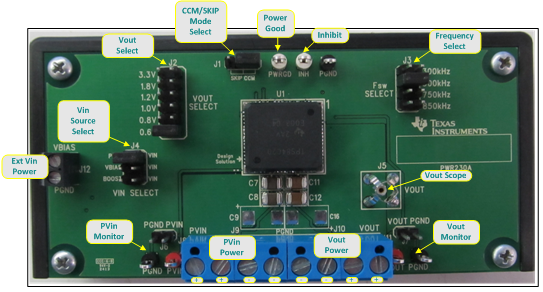SNVU283B August 2013 – December 2021 LMZ31520 , LMZ31530
2 Getting Started
Figure 2-1 highlights the user interface items associated with the EVM. The polarized PVin Power terminal block (J8) is used for connection to the host input supply and the polarized Vout Power terminal block (J11) is used for connection to the load. These terminal blocks can accept up to 16-AWG wire. The polarized VBIAS terminal block (J12) is used along with the VIN SELECT jumper (J4) when optional split power supply operation is desired. Refer to the LMZ31520 20-A Power Module With 3-V to 14.5-V Input Data Sheet and LMZ31530 30-A Power Module With 3-V to 14.5-V Input Data Sheet for further information on split power supply operation.
 Figure 2-1 LMZ315x0EVM User Interface
Figure 2-1 LMZ315x0EVM User InterfaceThe PVin Monitor (TP1) and Vout Monitor (TP3) test points located near the power terminal blocks are intended to be used as voltage monitoring points where voltmeters can be connected to measure PVIN and VOUT. The voltmeter references should be connected to the PGND test points (TP4 and TP2). Do not use these PVIN and VOUT monitoring test points as the input supply or output load connection points. The PCB traces connecting to these test points are not designed to support high currents.
The PVin Scope (J6) and Vout Scope (J7) test points can be used to monitor PVIN and VOUT waveforms with an oscilloscope. These test points are intended for use with un-hooded scope probes outfitted with a low-inductance ground lead (ground spring) mounted to the scope barrel. The two sockets of each test point are on 0.1-inch centers. The scope probe tip should be connected to the socket labeled PVIN or VOUT, and the scope ground lead should be connected to the socket labeled PGND.
The Vout Scope (J5) test point can be used to monitor the VOUT waveform with an oscilloscope. This test point is intended for use with an un-hooded scope probe with a 3.5-mm ground barrel.
The control test points located directly above the device are made available to test the features of the device. Refer to Section 3 for more information on the individual control test points.
The Vout Select jumper (J2) and Fsw Select jumper (J3) are provided for selecting the desired output voltage and appropriate switching frequency. Before applying power to the EVM, ensure that the jumpers are present and properly positioned for the intended output voltage. Always remove input power before changing the jumper settings.